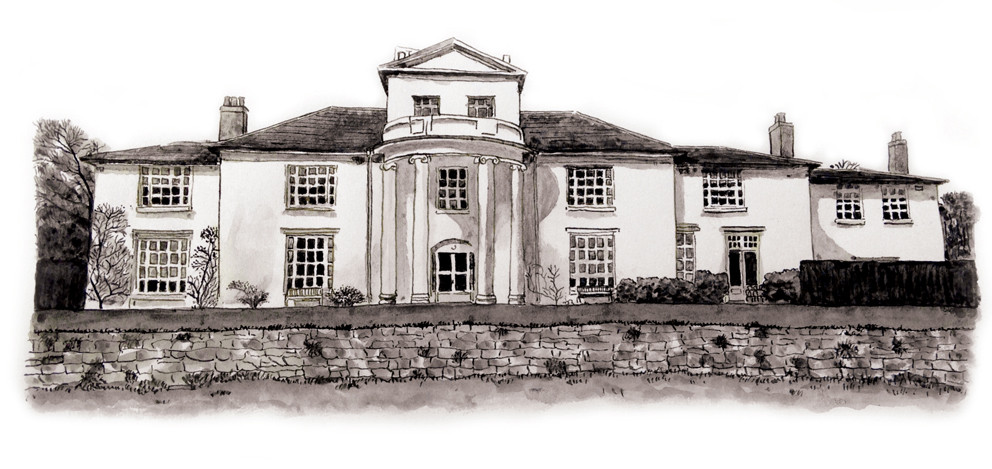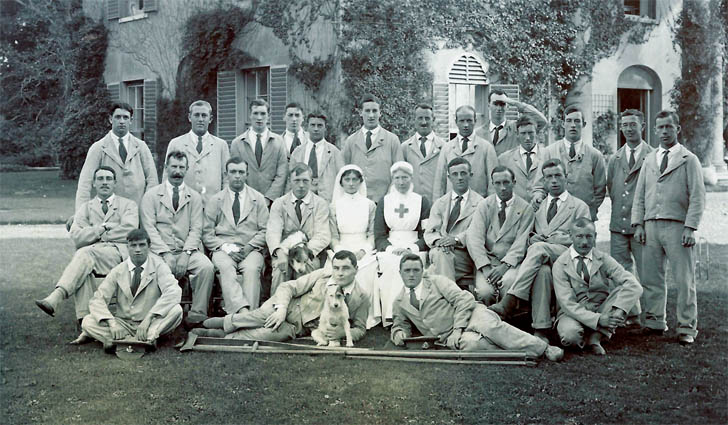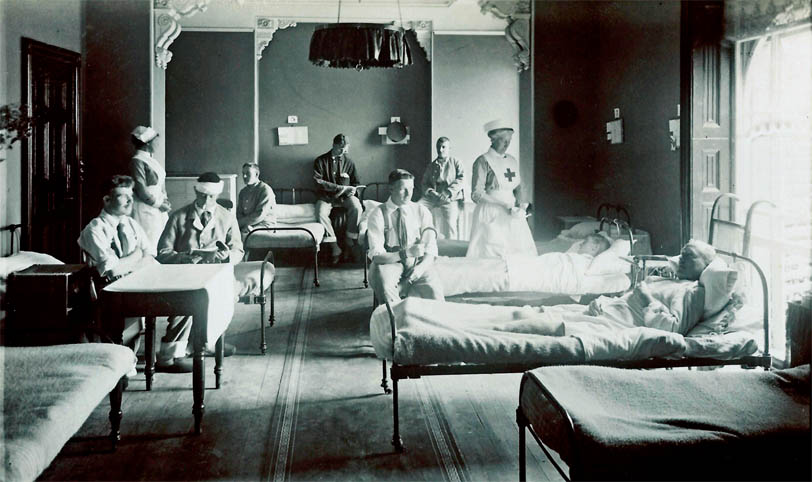Foxborough Hall today A home of the Red Cross between 1915 and 1918.
ILLUSTRATION: JENNIFER HALL. OAK GALL INK ON PAPER. 2019.
The British Red Cross Society, first established in 1870, has maintained a strong presence in this area since 1909, when Colonel Ranulphus John Carthew JP of Woodbridge Abbey was appointed the first Suffolk Red Cross Branch Director and founded the Woodbridge and District branch of the Red Cross. At the outbreak of the First World War, the Woodbridge Red Cross set up a hospital at Woodbridge School to look after sick or injured servicemen billeted in the area. The hospital was soon on the move to the Gate House on Church Street, Woodbridge, as the new school term was about to start. The Gate House quickly became unsuitable for the needs of the Red Cross and the Royal Army Medical Corps and a second change of premises was required. The move was reported in the Woodbridge Reporter and Wickham Market Gazette on 5th November 1914;
RAMC Hospital at Westholme, Woodbridge. – Jane Hayward – Commandant 12 November 1914
The “Hospital” has been removed from the “Gate House” to “Westholme” the residence for so many years of the late Mrs T Carthew, which is especially suitable for the purpose. The members of Suffolk No.2 VAD have been officially mobilised. They are therefore now on active service and expected to wear their uniform.
At the end of January 1915, Westholme closed as a hospital and permission was given to set up two wards in the Infant Department of Woodbridge Council School for three weeks. This did not go down well with the local families who, in turn, kept their children from attending school. This was due to the majority of the patients being treated for influenza.
The Suffolk County Council Education Committee refused to extend the period beyond three weeks and the Red Cross was forced to find alternative arrangements once more. After a brief stop at the Isolation Hospital at St Audry’s in Melton, Percy Crossman, the leaseholder of Foxborough Hall, offered it to the Red Cross as their new accommodation. Foxborough Hall was in the ownership of the Walford family and had been leased to Percy Crossman who was part of the brewing firm of Mann, Crossman and Paulin Ltd of the Albion Brewery in Whitechapel, East London. Percy had also allowed the Essex Yeomanry to use the grounds of Foxborough Hall before handing the building over to the Red Cross.
By 29th April 1915, the hospital was operational and the Hall was used to treat the sick and accident cases among the troops from the Eastern Mounted Brigade stationed in and around Woodbridge. The first contingent of wounded soldiers arrived from Henham Hall on 12th May 1915. In these early days, the commandant was Mrs Jane Hayward of The Highlands, Woodbridge, and the quartermaster was Mrs Gertrude Agnes Dow of Lowood, Hasketon. The hospital was staffed by members of No.2 Suffolk Voluntary Aid Detachment. The arrival of the men at Foxborough Hall was reported in the Woodbridge Reporter and Wickham Market Gazette in their edition dated 20th May 1915:
Patients at Foxborough Hall Red Cross Hospital with the Commandant, Amy Maitland Wilson seated middle right.
Arrival of Wounded at Woodbridge Hospital
The first contingent of wounded soldiers arrived at Foxboro’ Hall, about two miles from Woodbridge on Wednesday last (12th). By kindness of Mr Percy Crossman, the Hall has been utilised for the past few weeks as a hospital for some of the sick and accident cases among the troops from the Eastern Mounted Brigade stationed in and about Woodbridge, where they have received every care and attention from members of No.2 (Women’s) Voluntary Aid Detachment, under the supervision of Mrs L. W. Hayward, the commandant, and Mrs Dow, the Quarter-master.
About 10:30 a.m. on Wednesday of last week a telegram was received asking if a number of wounded soldiers could be received and a ready reply in the affirmative was at once sent. Active preparations were immediately undertaken, and about 5.30 in the afternoon the first batch of wounded patients arrived, being conveyed thither in motor cars, 21 coming from Henham Hall, 11 from Ampton and three from Halesworth – 35 in all. They are nearly all convalescent cases. The nursing staff has been augmented by three trained nurses, who will be assisted in the work of looking after and attending to the patients by members of the V.A.D.
Amongst the patients are Grenadier, Coldstream and Irish Guards, Rifle Brigade, Engineers, Canadians, Gordon Highlanders, Black Watch, Suffolks and men of various other units. Many of these will shortly be leaving for Convalescent Homes or on furlough, but it is believed the Hospital will continue to be filled up.
Most of the men are able to get about the grounds in fine weather, and enjoy playing football and bowls. They would be very glad of cricket equipment.
Friends of the Hospital will be welcome any day between 3 and 5 p.m. If any owners of motor cars or carriages will come and take patients for an hour’s drive any day between 2 and 3.45 or 4.30 and 5.45, they will be doing a really good and charitable work, and one that will be very highly appreciated by the convalescent men.
In order to help the men pass away the time newspapers and illustrated papers and games are much needed and appreciated. If any of our readers can help in this way they are invited to send their contributions to the “Reporter” Office, from where Mrs. Dow has arranged to take them to Foxboro’ Hall.”
Local people seized on the opportunity to help set up these hospitals as a means of actively supporting the war effort. Many donated equipment such as bedding, crockery and cooking utensils. There were also appeals for cricket equipment, magazines, books and games. Lists of donations to the Hall, together with the names of donors, were regularly published in the local press. One such entry records the gift of one hundred and seventy eggs collected by Melton school children as part of “The National Egg Collection for Wounded Soldiers and Sailors”. Donations of fruit, jam and cake were also welcome and it was agreed by Mr Arthur Fairweather, proprietor of the Woodbridge Reporter and Wickham Market Gazette, that they could
"be left at his shop on Tuesdays and Saturdays by 3pm when they will be fetched from (sic) the hospital."
Lady Laura Garrod of Wilford Lodge arranged for the daily delivery of five newspapers to the hospital and appeals were made for local people to invite patients to their homes for tea in an attempt to provide relief from what could be a tedious existence. One such request, placed in the Woodbridge Reporter and Wickham Market Gazette by the new commandant, Lady Agnes Farren, read:
One of our wants shortly will be the loan of some strong iron garden seats; strong things are absolutely essential for the lads, bless them.
Yours faithfully A F Farren.
The wounded were offered musical and theatrical entertainment in the form of variety concerts by members of the RAMC, together with two female VADs, known as the Medico Minstrels. The Woodbridge Reporter and Wickham Market Gazette reported on 3rd June 1915:
“The coach house was used as an impromptu theatre and provided good accommodation, even for a stretcher case. With Major Archibald as the Interlocutor, Staff Sergt. Hinton and Driver Millard as Bones and Tambo, fun and melody succeeded each other without a dull moment. Colonel Cross, during the interval, presented the commandant, Mrs L. W. Hayward, with a cheque for £15, the proceeds of a most successful concert given in the Lecture Hall, Woodbridge, by the Medico Minstrels last week.
This handsome sum will be most welcome in providing extras and luxuries in connection with the work the V.A.D. are carrying on at Melton for the wounded.
The promoters must be congratulated on the great success which has attended their efforts in organising this popular troupe, and the good results achieved in cheering and helping those we owe so much.”
The hospital was closed for a brief period during the early months of 1916 to allow for repairs and alterations. Later, in August, Lady Farren handed over her duties as commandant to Miss Amy Maitland Wilson who continued in the role until the hospital’s closure.
The women's section of the British Red Cross was organised into a series of detachments located in counties throughout the UK. Each detachment was headed by a commandant and other personnel typically included a medical officer, quartermaster, two trained nurses and twenty-two nursing volunteers.
The quartermaster was responsible to the commandant for keeping lists of furniture, stores, linen etc. as well as administrating the hospital finances.
One of the rooms used as a ward at Foxborough Hall. Charlotte Gaffney is standing to the right facing the window.
According to Red Cross records, some one hundred and twenty-nine people, predominantly women, were recorded as having spent time employed at Foxborough Hall during the Great War, either as paid workers or volunteers. These included medical officers, trained nursing staff, volunteers, ground staff and domestic workers. For many, especially trained nurses and mobile VADs, the postings at Melton were short-term attachments with staff being transferred to other settings as the war progressed. The female voluntary workers were frequently young and single. Their duties included cleaning, scrubbing and dusting, setting trays, cooking breakfasts; they lit fires and boiled up coppers full of washing. Volunteers also helped to dress, undress and wash the men. Home addresses would suggest that in this area, they more often came from relatively privileged middle-class family backgrounds where they were not necessarily expected to support themselves financially. Most of the domestic and ground staff in receipt of pay were recruited locally from more modest households.
The hospital continued to be well used and a newspaper report, dated October 1918, confirms that Foxborough Hall was full to capacity with every patient confined to his bed. Once again there was an appeal for gifts to comfort the suffering.
Foxborough Hall closed as a hospital in February 1919 after four years of operation. Those who had loaned goods and equipment were invited to contact the hospital to arrange collection. At the end of hostilities, the government presented an illuminated scroll to each hospital in the country together with a letter of thanks signed by Winston Churchill (Secretary of State for War).
Melton residents who worked at Foxborough Hall are covered elsewhere in this site and are listed here for reference:
Margaret Ida Bentham (Alma House, The Street. Melton);
Charlotte Gaffney (The Beeches, The Street, Melton);
Sylvia Eleanor Murray Hope (Long Spring, Woods Lane, Melton);
Harriet King (Valley Farm Cottages, Doe’s Alley, Melton);
Florence Lisette Lushington, (The Hermitage, Saddlemakers Lane, Melton);
Phyllis Lilian Murray; (The Red Towers, Yarmouth Road, Melton);
Violet Irene Charlotte Murray (The Red Towers, Yarmouth Road, Melton);
Marguerite Wrentmore (Studley, Melton Road, Melton).
The biographies of some of the other people working at the Red Cross Hospital can be found here: Foxborough Hall Red Cross Hospital Staff
